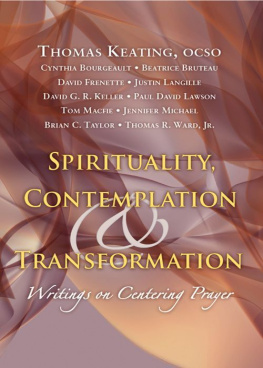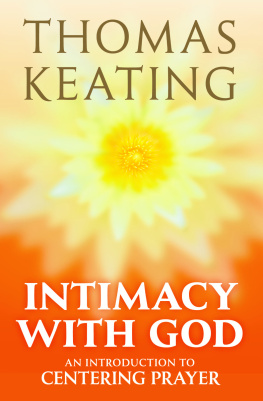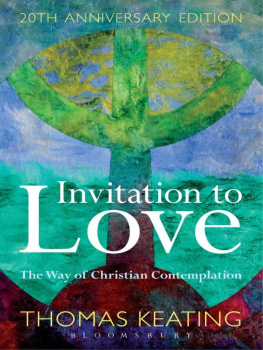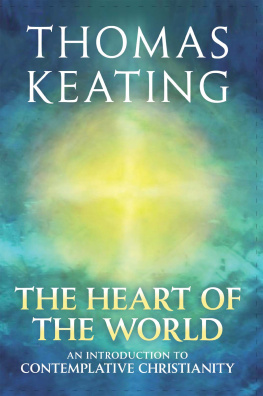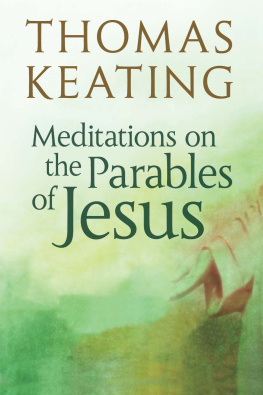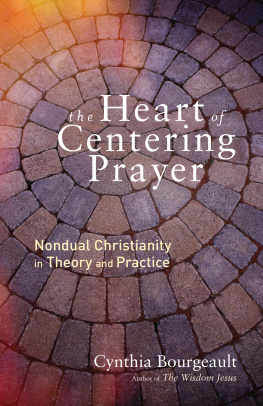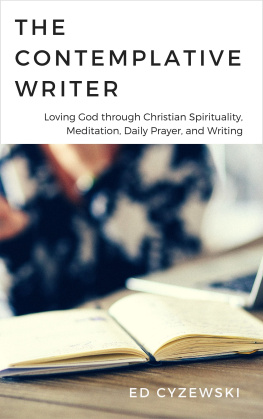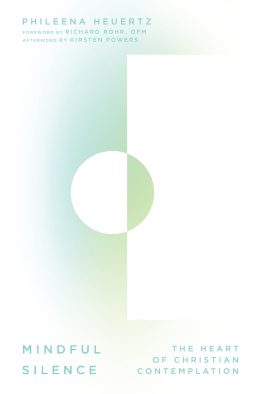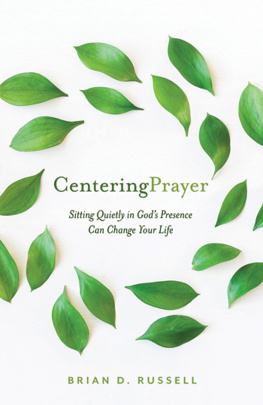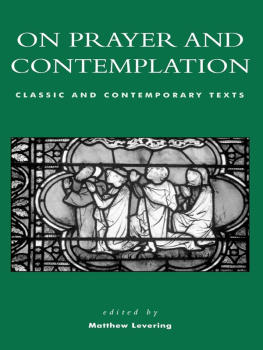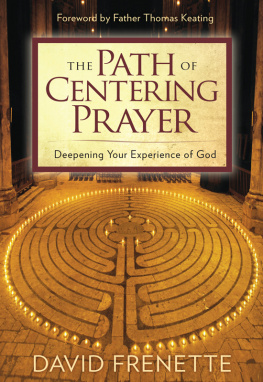
2008
LANTERN BOOKS
128 Second Place, Brooklyn, NY 11231
Copyright St. Benedict's Monastery
Snowmass, Colorado, 2008
All rights reserved. No part of this book may be reproduced, stored in a retrieval system or transmitted in any form or by any means, electronic, mechanical, photocopying, recording or otherwise, without the written permission of Lantern Books.
COVER IMAGE BY DIN
LIBRARY OF CONGRESS CATALOGING-IN-PUBLICATION DATA
Spirituality, contemplation, and transformation : writings on centering prayer / Thomas Keating and others.
p. cm.
Includes bibliographical references.
ISBN-13: 978-1-59056-110-2 (alk. paper)
ISBN-10: 1-59056-110-4 (alk. paper)
1. Contemplation. 2. PrayerChristianity. I. Keating, Thomas.
BV5091.C7S66 2007
242dc22
2007042859
Printed in the United States
TABLE OF CONTENTS
.
.
.
ACKNOWLEDGMENTS
This volume consists of essays that were first published in two separate issues of the Sewanee Theological Review (STR): Spirituality, Contemplation, and Transformation, vol. 50:3 (Pentecost 2007), and Contemplative Prayer, vol. 48:2 (Easter 2005). The latter won the Award of Excellence at the 2006 Episcopal Communicators Conference for Best Series of Articles on Theological Reflection. For this book, the essays have been adapted and edited slightly for repetition and style.
Introduction
I'M NOT REALLY RELIGIOUS: Spirituality in the Twenty-First Century
Thomas R. Ward, Jr.
S PIRITUALITY IS IN the air. Consider the following quotation:
I'm really not religious, at least not in any institutional sense, students often say to me. Then they add, with varying degrees of urgency, But I have a strong commitment to spirituality.
Mark McIntosh begins his insightful Mystical Theology with these words, which are familiar to those of us who serve the institutional church. In an atypical but spectacular error of judgment, Paul Tillich suggested in 1963 that, while almost anything else in religious symbolism could be resuscitated, spiritual and spirituality were irrevocably dead and certainly not likely to be culturally present again.
The revival of contemplative dimensions of the Christian gospel is a remarkable part of this larger phenomenon, and the centering prayer movement is a major manifestation of the contemplative revival. What distinguishes this movement from many of the current spiritualities is its grounding in the Christian tradition and the institutional church. It is as if some of our buried treasures are being discovered, brought to life, and put to use. One thinks of The Cloud of Unknowing, for instance, or of the Spiritual Espousals of Jan van Ruysbroeck. As important as our rediscovery of such texts is, even more important are specific practices that emerge from them and the tradition they embody. Centering prayer as taught by Thomas Keating is one such practice.
The centering prayer movement is a responsible attempt on the part of laity, parish clergy, monks, and seekers to respond to the obvious spiritual hunger of our day. This book offers a glimpse into this movement through the eyes of some faithful participants. From my perspective this movement offers one good way to maintain the institutional integrity of our tradition while we open ourselves to the Holy Spirit, that beauty ever ancient and ever new is the source of all spirituality.

On October 12, 2005, Thomas Keating addressed my class of juniors at The School of Theology during a visit to the Sewanee Mountain. This was a one-semester class that had as its title Spirituality for Ministry. We read several books together and had much conversation, but the central focus of the class was to encourage these prospective priests to develop a deep, regular life of personal prayer. When I told Keating what my overall intention was, I did not ask him to address any particular theme in this session. I wanted to leave him free to say what he would to the group. In the course of his presentation he made the following comments, among others:
The Christian religion is primarily about a transformation of consciousness. This takes spiritual practice and the cultivation of wisdom. In another time this was called cultivating the supernatural organism, what Paul called a new creation. So the main thing is to be transformed into God, what the early church called deification, theosis, divinization.
He went on to develop this theme in more detail.
Later in the refectory over lunch, Keating and Christopher Bryan talked about what became the Pentecost 2007 issue of the Sewanee Theological Review (see Acknowledgments) and what the theme should be. Bryan said, What about transformation? That was the subject of the class. It is certainly timely and appropriate. I think it would provide a good theme for our next issue devoted to contemplation. And so the issue of STR began to take shape.
Do not be conformed to this world, but be transformed by the renewing of your minds, so that you may discern what is the will of Godwhat is good and acceptable and perfect (Rom. 12:2). We know we ought to be transformed. In the depths of our hearts we know that we have been transformed in our baptisms. But we also know that we are works in progress, that God has more transforming work to do in us.
Through our knowing Christ in the Paschal Mystery, God transforms us. And by God's grace through the liturgyand in personal prayer beyond the liturgywe make ourselves available for Christ Jesus to continue to make us his own.
If the main theme of this book is transformation, a secondary and related theme is contemplation. For Thomas Keating and many others, contemplation is a means to the transformation that Paul describes. As Keating said in that class on that day, the tradition tells us that we need a spiritual practice that will open us to the transforming power of God.
Chapter 1
A TRADITIONAL BLEND: The Contemplative Sources of Centering Prayer
Thomas Keating, OCSO
S OME PEOPLE USE herb tea or a blend of herb teas. It seems to me that the Christian contemplative tradition can be compared to a blend of the finest herb teas. Thus The Cloud of Unknowing is one such tea. Others include the Jesus Prayer of the Eastern Orthodox tradition, lectio divina as practiced by the monastics of the early Middle Ages, aspirations (repetition of phrases from scripture or one's own devotion), being in God's presence in pure faith, and turning to God in love as recommended by Saint John of the Cross. Centering prayer is a blend of elements drawn from all these traditions. A primary source is The Cloud of Unknowing, but we have incorporated other teas to establish a special blend.
While developing a special blend of herb teas from the Christian tradition, centering prayer has also tried to place this teaching in dialogue with the psychological discoveries of our time (especially our awareness of what we call the unconscious), as well as with the insights of other contemporary sciences such as quantum mechanics and the new physics. Centering prayer has learned from Eastern methods the importance of the body's posture and a proper method of breathing, without incorporating their particular belief systems or copying their precise practicessomewhat like adding a touch of sugar or milk to a cup of tea! The tea is still considered tea, even with a dash of milk or sugar, is it not?
Next page
